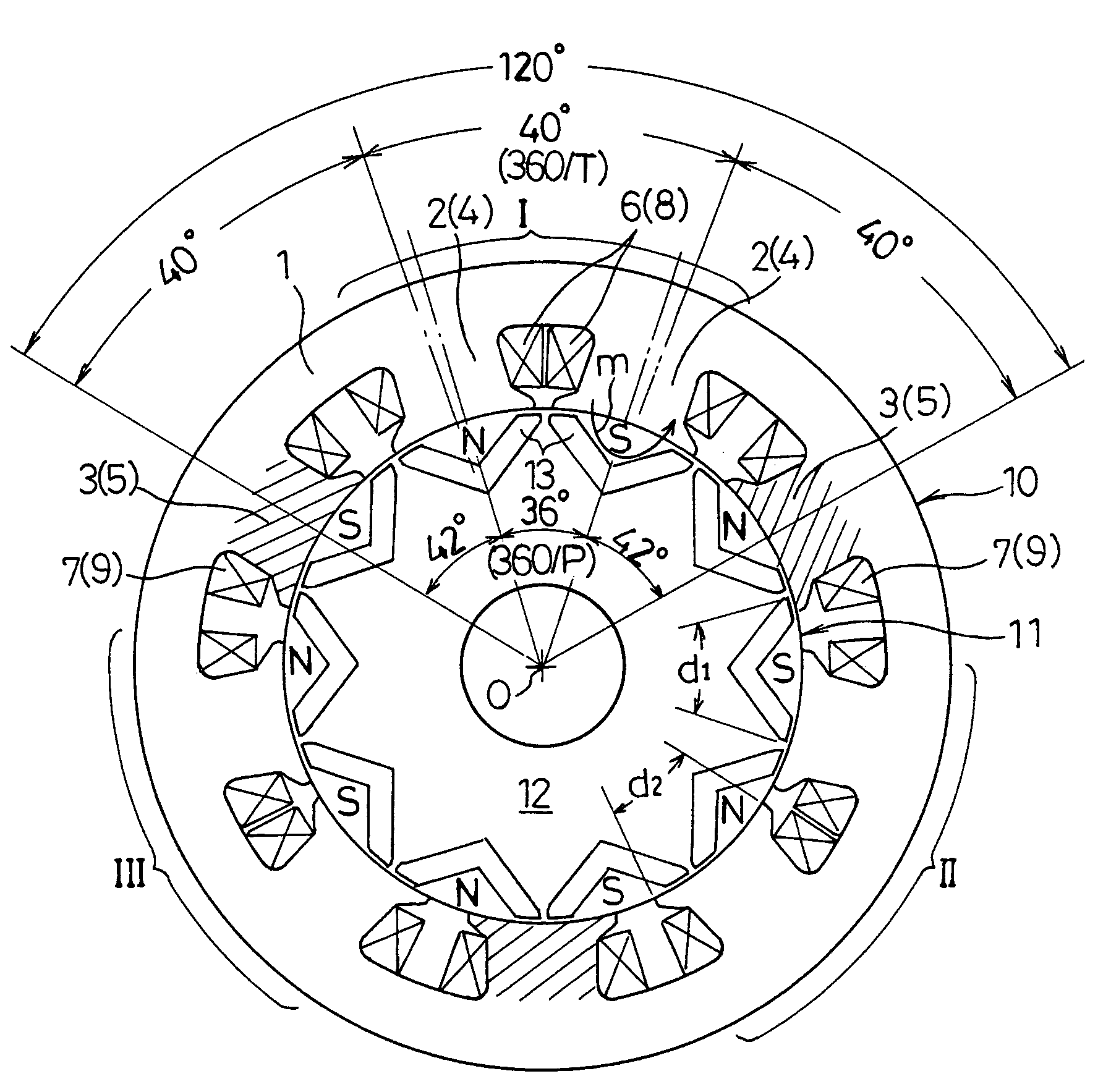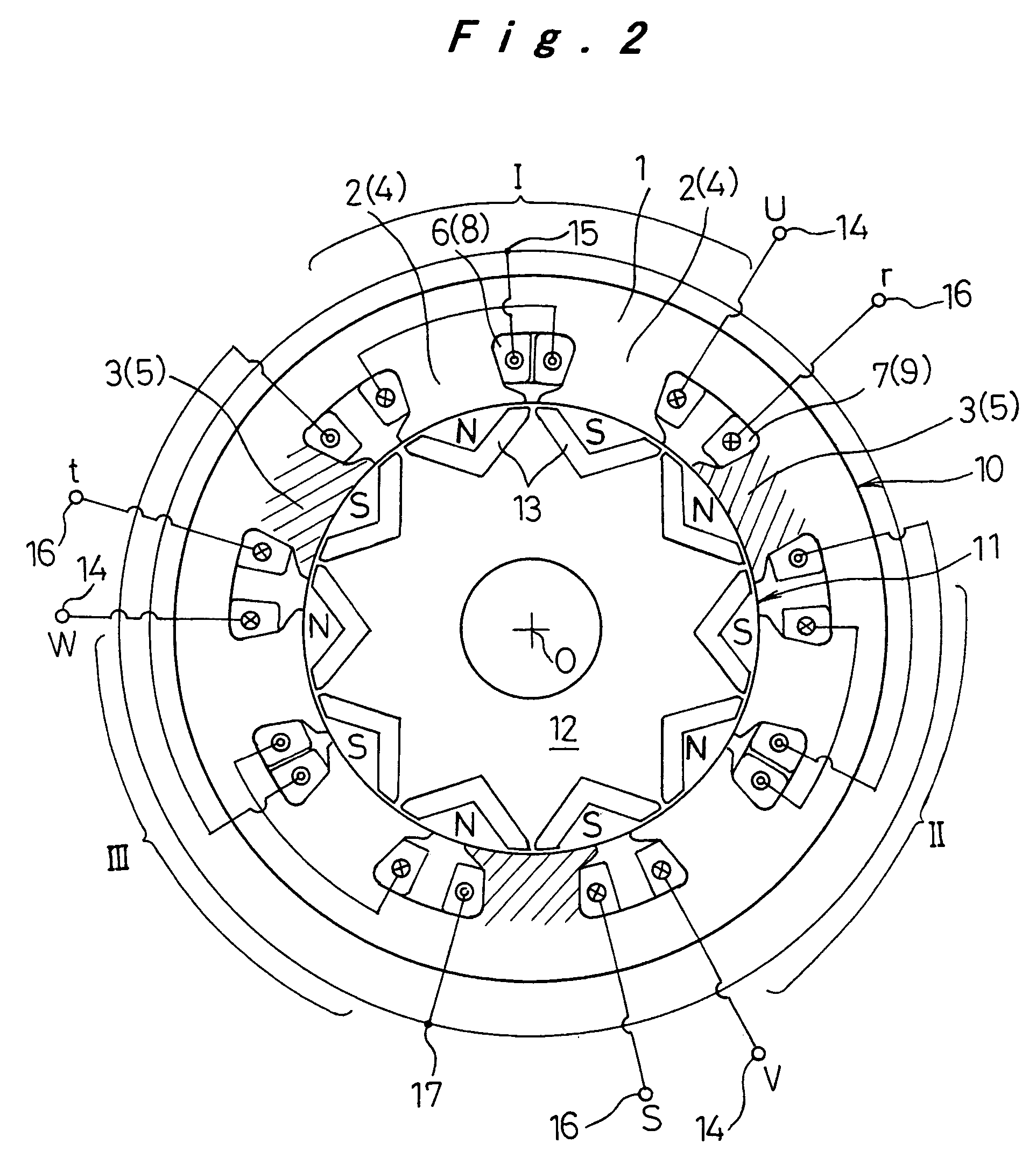Motor generator
a motor generator and motor technology, applied in the direction of synchronous generators with multiple outputs, magnetic circuit rotating parts, magnetic circuit shapes/forms/construction, etc., can solve the problems of increasing the space for motor generators, increasing costs, and increasing the size of motor generators, so as to reduce installation space and reduce costs
- Summary
- Abstract
- Description
- Claims
- Application Information
AI Technical Summary
Benefits of technology
Problems solved by technology
Method used
Image
Examples
first embodiment
[0051]A first embodiment of the motor generator according to the invention will be described with reference to FIGS. 1 to 6. FIG. 1 is a vertical sectional view of the motor generator of the invention with respect to the rotating axis. FIG. 2 is a connecting diagram of the winding. Referring to FIG. 1, a stator core 1 formed by stacking electromagnetic steel plates is provided with a plurality of stator teeth 2 that constitute a first stator teeth section 4, and a plurality of stator teeth 3 (shaded to be distinguished from the stator teeth 2) that constitute a second stator teeth section 5. A winding 6 that constitutes a first winding section 8 is wound around the stator teeth 2, and a winding 7 that constitutes a second winding section 9 is wound around the stator teeth 3 so as to form a stator 10.
[0052]Meanwhile a rotor 11 is formed by embedding a plurality (even number) of permanent magnets 13 at uniform intervals in the rotor core 12 formed as the stacked electromagnetic plates...
second embodiment
[0068]A second embodiment of the invention will be described with reference to FIGS. 7A and 7B. The structural elements identical to those described in the first embodiment will be designated by the same reference numerals, and the description thereof will be omitted and the following descriptions focus mainly on the points of difference from the preceding embodiment.
[0069]In the previous embodiment, the rotor 11 is of magnet type formed by embedding permanent magnets 13 in the rotor core 12. In this embodiment, the rotor 11 is formed by stacking magnet type rotor portions 21 and reluctance type rotor portions 22 in the axial direction as shown in FIG. 7A. The magnet type rotor portion 21 is formed by embedding the permanent magnets 13 in the rotor core 12. The reluctance type rotor portion 22, as shown in FIG. 7B, has stator teeth 25 by the number equal to that of the permanent magnets 13 by forming recess portions 24 on the outer periphery of the rotor core 23 at equal intervals.
[...
third embodiment
[0071]A third embodiment of the invention will be described with reference to FIG. 8. The motor generator in the previous embodiment has three pairs in total, that is, two pairs in the first stator teeth section 4, and one pair in the second stator teeth section 5. The motor generator in this embodiment includes five pairs in total, that is, three pairs in the first stator teeth section 4, and two pairs in the second stator teeth section 5, fifteen stator teeth in total, and sixteen poles (not shown) of the permanent magnets 13. In the case where the second stator teeth section 5 has more than one pair, the pitch of the stator teeth 2 of the first stator teeth section 4 is set to 24° (360 / T), and the pitch of the stator teeth 3 of the second stator teeth section 5 is set to 22.5° (360 / P). The length of the leg 18 that extends toward both sides in the circumferential direction is adjusted at the distal ends of each of the stator teeth 2 and 3 such that the open slot angle os1 between...
PUM
 Login to View More
Login to View More Abstract
Description
Claims
Application Information
 Login to View More
Login to View More - R&D
- Intellectual Property
- Life Sciences
- Materials
- Tech Scout
- Unparalleled Data Quality
- Higher Quality Content
- 60% Fewer Hallucinations
Browse by: Latest US Patents, China's latest patents, Technical Efficacy Thesaurus, Application Domain, Technology Topic, Popular Technical Reports.
© 2025 PatSnap. All rights reserved.Legal|Privacy policy|Modern Slavery Act Transparency Statement|Sitemap|About US| Contact US: help@patsnap.com



